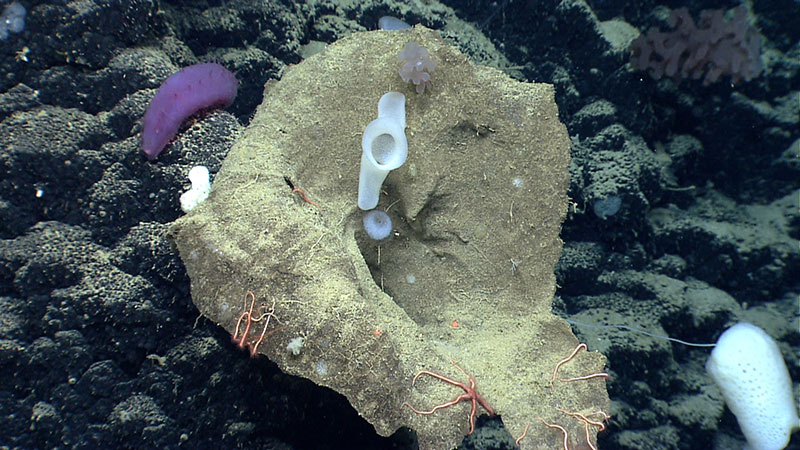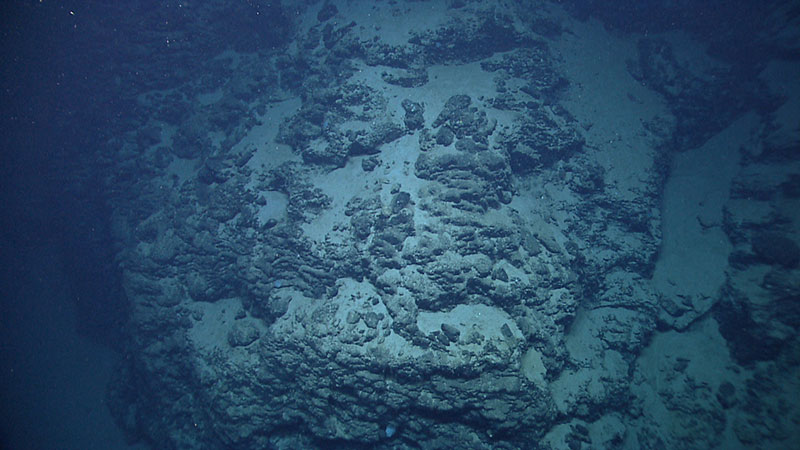
by Martha Nizinski and Amanda Demopoulos, Leg 2 Science Leads
In consultation from Scott France, Tim Shank, and Les Watling
August 6, 2013

Corals were diverse on Mytilus Seamount, but composition and abundance of corals differed between the north and south side of the seamount. We observed this colony of Jasonisis, a bamboo coral, with numerous crinoid associates. Image courtesy of the NOAA Office of Ocean Exploration and Research, Northeast U.S. Canyons Expedition 2013. Download larger version (jpg, 1.6 MB).
Seamounts are underwater volcanoes that occur at great depths and represent highly heterogeneous seascapes. Scientists are interested in these deep-sea habitats for a variety of reasons, including understanding the diversity, abundance, and composition of the animals that live there; how similar the assemblages of organisms are among seamounts; and how seamount assemblages compare to other deep-sea habitats, including canyons.
During this expedition, we explored Mytilus Seamount on two separate dives, one on the north side and one on the south side of the seamount. Mytilus is part of the New England Seamount Chain and is one of the deepest (over 3,000 meters at the base) and least-explored seamounts in the U.S. Exclusive Economic Zone. Earlier expeditions had conducted some work on Mytilus, but we still have a great deal to learn.

Sponges are abundant and diverse at Mytilus Seamount. Notice this large “witch’s hat” sponge provides structure for numerous hexactinellid or glass sponges as well as some orange brittle stars. Image courtesy of the NOAA Office of Ocean Exploration and Research, Northeast U.S. Canyons Expedition 2013. Download larger version (jpg, 1.4 MB).
Over the course of two dives, we were able to make some comparisons between the north and south sides of the seamount. The north side was characterized with gently and steeply sloping basalt pillars, whereas the south side had more soft sedimented areas with scattered cobbles both in the deepest areas as well as further up slope. Overall, the diversity of corals was similar, but the composition and abundance of particular species differed between the two sides.
Of particular note is that no scleractinian (stony) corals were observed at the seamount. There were several species of sponges observed; some were quite large in size. Many of these sponges were only documented on the seamount dives of the expedition. There were few fish species observed during our dives including halosaurs, ophidids, rattails, synaphobranchid eels, Antimora, Bathychaunax, and Bathysaurus. We certainly can’t characterize a whole seamount in just two dives!

The deep-sea lizard fish (Bathysaurus) was observed on the south side of Mytilus Seamount. This fish sits on the bottom and grabs prey from the water column. Image courtesy of the NOAA Office of Ocean Exploration and Research, Northeast U.S. Canyons Expedition 2013. Download larger version (jpg, 1.4 MB).
We were fortunate that several of our shore-side scientists had explored other seamounts within the New England Seamount Chain and shared their thoughts with us. In particular, they identified a few possible reasons why the organisms we observed at seamounts are different from those at the canyons.
One big difference is the underlying foundation. Seamounts are volcanic in origin, thus their sediments are derived from the ocean, whereas canyon sediments are primarily terrigenous. Thus, seamounts and canyons have different substrate types due to their origin and the underlying sediments may influence the fauna that occur there.
Depth and current flow over local topography (or steepness) of the features may also influence colonization of particular sedentary invertebrates. As is often the case, location is everything. Currents will influence food supply, larval delivery, and fine sediment accumulation. Seamounts and canyons explored on this expedition are influenced by different current regimes which likely influence the amount of sedimentation and dispersal of larvae to these locations.
Finally, we have noted at both Mytilus and the canyons that sedentary fauna have patchy distributions. Thus, where we begin and end our dive transects could make all the difference in whether we observe these fauna in great abundance and diversity or just the opposite.
We conclude that the composition of fauna is different between seamounts and canyons, but with so little environmental information (e.g., current regime) we are not sure why. We will need to collect more information before we have a better understanding of the diversity and distribution of fauna associated with these deep-sea habitats.

This view of steep basalt pillars on the north side of Mytilus Seamount resembles a lava flow, illustrating the seamount’s volcanic origin. Image courtesy of the NOAA Office of Ocean Exploration and Research, Northeast U.S. Canyons Expedition 2013. Download larger version (jpg, 1.3 MB).